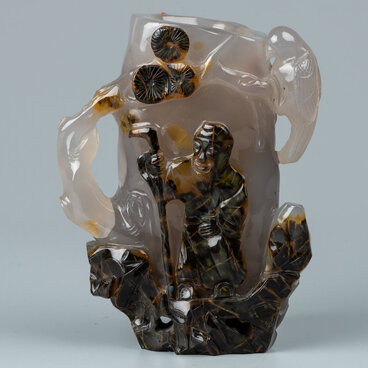The Samara Regional Art Museum presents a group of ceramicware created in Satsuma province, which for a long time was kept in the collection of the entrepreneur and founder of a brewery Alfred von Vacano. The visitors can see dozens of products from Satsuma workshops, covered with ivory glaze with tiny surface cracks — the so-called “crackle glaze” — and painted with polychrome paints and gold.
Satsuma is the historical name of a province on the territory of present-day Kagoshima Prefecture in the south of the Kyushu Island. From the ancient times, the province has been famous for its refined porcelain. Until the 16th century, traditional Japanese ceramicware of a reddish-brown color was produced on the island, covered with a translucent colorless glaze with a simple rectilinear pattern: such sturdy and high-quality products were intended for use in everyday life. However, after deposits of white ceramic clay had been discovered on Kyushu, the style of Satsuma ceramics changed. Local clay after firing turned into high-quality thin-walled white porcelain. Therefore, it is customary to divide Satsuma-style products into two fundamentally different categories: the original dark Ko-Satsuma ceramics of the early period and exquisitely decorated thin-walled porcelain of the late period intended for export (Kyo-Satsuma).
The picturesque design of the pottery included a variety of motifs: battle scenes, genre scenes, depictions of episodes from literary works and figures of saints. Often genre painting was combined with geometric patterns and ornaments. Inscriptions with the names of the artists who created the shape and painted the items were left on the bottom of the products. The works from the collection of Alfred von Vacano are made in the nishikide style (or “brocade style”), in which picturesque images and ornaments completely cover the entire surface of the items. The works are dated to the 19th century, when most of the Satsuma workshops produced pottery for export.
The vase with figured handles in the shape of dragons is a vivid example of exquisite Satsuma ceramics. Gold dominates the color palette of the vase. It is decorated with the image of a battle scene on one side, and a host of gods on the other. One can see a cross inscribed in a circle on the neck of the vase — it is the “kamon”, the family coat of arms of the Shimazu clan (an ancient samurai family from Satsuma). Initially, such a seal indicated that the item belonged to representatives of this family, but in the era of mass production it simply became a marketing tool.
Satsuma is the historical name of a province on the territory of present-day Kagoshima Prefecture in the south of the Kyushu Island. From the ancient times, the province has been famous for its refined porcelain. Until the 16th century, traditional Japanese ceramicware of a reddish-brown color was produced on the island, covered with a translucent colorless glaze with a simple rectilinear pattern: such sturdy and high-quality products were intended for use in everyday life. However, after deposits of white ceramic clay had been discovered on Kyushu, the style of Satsuma ceramics changed. Local clay after firing turned into high-quality thin-walled white porcelain. Therefore, it is customary to divide Satsuma-style products into two fundamentally different categories: the original dark Ko-Satsuma ceramics of the early period and exquisitely decorated thin-walled porcelain of the late period intended for export (Kyo-Satsuma).
The picturesque design of the pottery included a variety of motifs: battle scenes, genre scenes, depictions of episodes from literary works and figures of saints. Often genre painting was combined with geometric patterns and ornaments. Inscriptions with the names of the artists who created the shape and painted the items were left on the bottom of the products. The works from the collection of Alfred von Vacano are made in the nishikide style (or “brocade style”), in which picturesque images and ornaments completely cover the entire surface of the items. The works are dated to the 19th century, when most of the Satsuma workshops produced pottery for export.
The vase with figured handles in the shape of dragons is a vivid example of exquisite Satsuma ceramics. Gold dominates the color palette of the vase. It is decorated with the image of a battle scene on one side, and a host of gods on the other. One can see a cross inscribed in a circle on the neck of the vase — it is the “kamon”, the family coat of arms of the Shimazu clan (an ancient samurai family from Satsuma). Initially, such a seal indicated that the item belonged to representatives of this family, but in the era of mass production it simply became a marketing tool.






